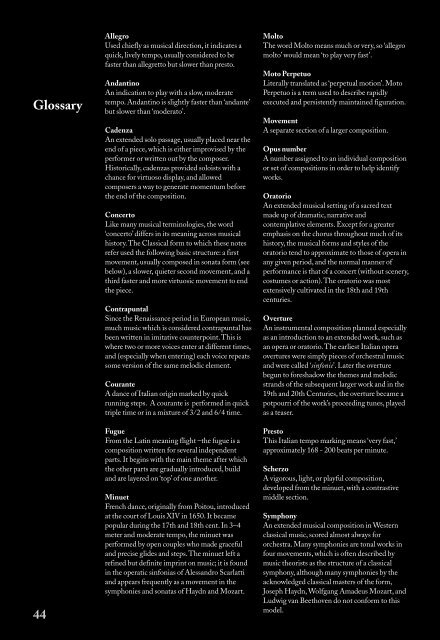download here. - Orchestra of the Age of Enlightenment
download here. - Orchestra of the Age of Enlightenment
download here. - Orchestra of the Age of Enlightenment
You also want an ePaper? Increase the reach of your titles
YUMPU automatically turns print PDFs into web optimized ePapers that Google loves.
Glossary<br />
44<br />
Allegro<br />
Used chiefly as musical direction, it indicates a<br />
quick, lively tempo, usually considered to be<br />
faster than allegretto but slower than presto.<br />
Andantino<br />
An indication to play with a slow, moderate<br />
tempo. Andantino is slightly faster than ‘andante’<br />
but slower than ‘moderato’.<br />
Cadenza<br />
An extended solo passage, usually placed near <strong>the</strong><br />
end <strong>of</strong> a piece, which is ei<strong>the</strong>r improvised by <strong>the</strong><br />
performer or written out by <strong>the</strong> composer.<br />
Historically, cadenzas provided soloists with a<br />
chance for virtuoso display, and allowed<br />
composers a way to generate momentum before<br />
<strong>the</strong> end <strong>of</strong> <strong>the</strong> composition.<br />
Concerto<br />
Like many musical terminologies, <strong>the</strong> word<br />
‘concerto’ differs in its meaning across musical<br />
history. The Classical form to which <strong>the</strong>se notes<br />
refer used <strong>the</strong> following basic structure: a first<br />
movement, usually composed in sonata form (see<br />
below), a slower, quieter second movement, and a<br />
third faster and more virtuosic movement to end<br />
<strong>the</strong> piece.<br />
Contrapuntal<br />
Since <strong>the</strong> Renaissance period in European music,<br />
much music which is considered contrapuntal has<br />
been written in imitative counterpoint. This is<br />
w<strong>here</strong> two or more voices enter at different times,<br />
and (especially when entering) each voice repeats<br />
some version <strong>of</strong> <strong>the</strong> same melodic element.<br />
Courante<br />
A dance <strong>of</strong> Italian origin marked by quick<br />
running steps. A courante is performed in quick<br />
triple time or in a mixture <strong>of</strong> 3⁄2 and 6⁄4 time.<br />
Fugue<br />
From <strong>the</strong> Latin meaning flight –<strong>the</strong> fugue is a<br />
composition written for several independent<br />
parts. It begins with <strong>the</strong> main <strong>the</strong>me after which<br />
<strong>the</strong> o<strong>the</strong>r parts are gradually introduced, build<br />
and are layered on ‘top’ <strong>of</strong> one ano<strong>the</strong>r.<br />
Minuet<br />
French dance, originally from Poitou, introduced<br />
at <strong>the</strong> court <strong>of</strong> Louis XIV in 1650. It became<br />
popular during <strong>the</strong> 17th and 18th cent. In 3–4<br />
meter and moderate tempo, <strong>the</strong> minuet was<br />
performed by open couples who made graceful<br />
and precise glides and steps. The minuet left a<br />
refined but definite imprint on music; it is found<br />
in <strong>the</strong> operatic sinfonias <strong>of</strong> Alessandro Scarlatti<br />
and appears frequently as a movement in <strong>the</strong><br />
symphonies and sonatas <strong>of</strong> Haydn and Mozart.<br />
Molto<br />
The word Molto means much or very, so ‘allegro<br />
molto’ would mean ‘to play very fast’.<br />
Moto Perpetuo<br />
Literally translated as ‘perpetual motion’. Moto<br />
Perpetuo is a term used to describe rapidly<br />
executed and persistently maintained figuration.<br />
Movement<br />
A separate section <strong>of</strong> a larger composition.<br />
Opus number<br />
A number assigned to an individual composition<br />
or set <strong>of</strong> compositions in order to help identify<br />
works.<br />
Oratorio<br />
An extended musical setting <strong>of</strong> a sacred text<br />
made up <strong>of</strong> dramatic, narrative and<br />
contemplative elements. Except for a greater<br />
emphasis on <strong>the</strong> chorus throughout much <strong>of</strong> its<br />
history, <strong>the</strong> musical forms and styles <strong>of</strong> <strong>the</strong><br />
oratorio tend to approximate to those <strong>of</strong> opera in<br />
any given period, and <strong>the</strong> normal manner <strong>of</strong><br />
performance is that <strong>of</strong> a concert (without scenery,<br />
costumes or action). The oratorio was most<br />
extensively cultivated in <strong>the</strong> 18th and 19th<br />
centuries.<br />
Overture<br />
An instrumental composition planned especially<br />
as an introduction to an extended work, such as<br />
an opera or oratorio. The earliest Italian opera<br />
overtures were simply pieces <strong>of</strong> orchestral music<br />
and were called ‘sinfonie’. Later <strong>the</strong> overture<br />
begun to foreshadow <strong>the</strong> <strong>the</strong>mes and melodic<br />
strands <strong>of</strong> <strong>the</strong> subsequent larger work and in <strong>the</strong><br />
19th and 20th Centuries, <strong>the</strong> overture became a<br />
potpourri <strong>of</strong> <strong>the</strong> work’s proceeding tunes, played<br />
as a teaser.<br />
Presto<br />
This Italian tempo marking means ‘very fast,’<br />
approximately 168 - 200 beats per minute.<br />
Scherzo<br />
A vigorous, light, or playful composition,<br />
developed from <strong>the</strong> minuet, with a contrastive<br />
middle section.<br />
Symphony<br />
An extended musical composition in Western<br />
classical music, scored almost always for<br />
orchestra. Many symphonies are tonal works in<br />
four movements, which is <strong>of</strong>ten described by<br />
music <strong>the</strong>orists as <strong>the</strong> structure <strong>of</strong> a classical<br />
symphony, although many symphonies by <strong>the</strong><br />
acknowledged classical masters <strong>of</strong> <strong>the</strong> form,<br />
Joseph Haydn, Wolfgang Amadeus Mozart, and<br />
Ludwig van Beethoven do not conform to this<br />
model.



